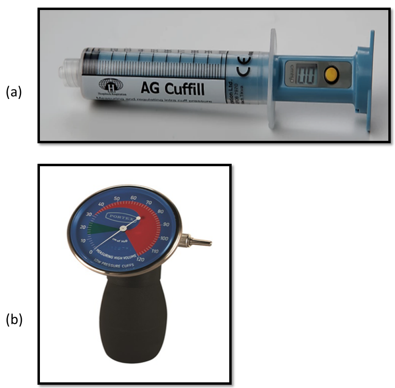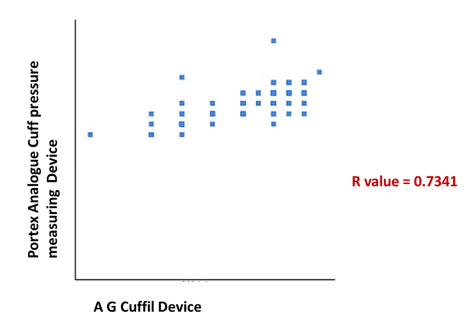Introduction
Intubation with endotracheal tube (ETT) has been regarded as a benchmark of maintaining the airway. The cuff at the end of the tracheal tube plays a vital role by preventing leakage of gases, prevention of aspiration, and holding the tube in situ. The cuff pressure to prevent air leakage and aspiration has been found to be 20-30 cm of water. Various complications like tracheal pain, vocal cord paralysis, tracheo-oesophageal fistula formation, tracheal stenosis, and tracheal perforation are observed if cuff pressure is not maintained. Obstruction to mucosal blood flow occurs at a pressure above 30cmH2O. In patients after anesthesia sore throat is usually due to ischaemia in oropharyngeal and tracheal mucosa.1, 2, 3, 4 Mucosal injuries by excessive cuff pressure typically occur 1-3 hours after intubation, but in patients with low cardiac output and unstable hemodynamic mucosal injury happens even in low cuff pressure.5, 6, 7, 8 Maintaining normal cuff pressure is challenging due to possible leakage post inflation.9, 10, 11, 12
Various techniques are practiced to maintain adequate ETT cuff pressure. The first one is measuring ETT cuff pressure by connecting a pressure gauge device to the pilot balloon of the ETT. Some devices, such as the Analog or digital manometer, are in practical usage.13, 14 The second technique is the manual method, which is the most commonly practiced. This technique, indirectly, measures the ETT cuff pressure by palpating the ETT pilot balloon and based on one’s experience. Although it is commonly used, this technique will not provide full proof of patient safety.15, 16 Since measuring devices like Analog manometers is bulky, the manual palpation technique is most commonly practiced. AG CUFFILL device is a newer product in the market which is used for measuring cuff pressure and is easy to carry, and a digital display is present. In this study, we aimed to see the efficacy and ease of AG CUFFILL with that of standard technique PORTEX cuff inflator.
Materials and Methods
After obtaining institutional ethical clearance and informed written consent from the relatives, this study was conducted. A total of 100 each, ETT pressure cuff readings were taken independently for AG CUFFILL device and standard Portex Analog manometer (Figure 1 a and 1b). The patients aged more than 16 years who were intubated and on ventilator were included in this study. To maintain uniformity, we did exclude the patient who are having cuffed tracheostomy tubes. The measurement of ETT cuff pressure for the same patient was allowed if the last recorded reading was more than 24 hours. The critical care nurse who is not involved in this study took all the readings. The readings from each are recorded. If the pressure measurement was done in a single attempt, then it is considered to be easy and if more number of attempts were used then it was considered as difficult. Thus, the ease of use of the device is also recorded.
Results
A total of 100 each, ETT pressure cuff readings were taken independently for AG CUFFILL device and standard Portex Analog manometer. Out of 100 patients, 61 patients (61%) were male and 39 patients (39%) were female. Mean cuff pressure of ETT using AG CUFFILL was 36.29±6.36 cm H2O and using PORTEX was 33.97±6.16 cm H2O. The mean difference in the values between the cuff pressure measured by AG CUFFILL and PORTEX was ± 2.67. The ease of measurement of ETT cuff pressure 100% using A G CUFFILL equipment, while with Portex analog manometer was 96%. Pearson correlation was calculated between the mean readings of both groups (Figure 2). The R value of Pearson correlation is 0.7341.
Discussion
There are various advantages of cuffed endotracheal tube viz, prevention of aspiration, adequate sealing which inturn helps for proper mechanical ventilation and keeping the ETT in situ. For all these purposes, it is critical to maintain adequate ETT cuff pressure. It is impossible to visualize the ETT cuff or direct intra cuff pressure measurement once insertion is done, thus making indirect pressure measurement the only option. Various techniques are practiced to measure the ETT cuff pressure. In this study, we aimed to compare two devices; the standard Portex analoge manometer with a digital AG CUFFILL device.
Here in our study, we compared the ease of utilization of the equipment. All 100 readings for each device were taken by a resident of anaesthesiology who was trained before the conduct of the study. A Pearson’s correlation was calculated for the mean cuff pressure in both the groups. The calculated R value is 0.7341 which shows a moderate positive correlation between the two device’s readings. There are no previous such studies to make a comparison of our study outcomes.
In this study, we included 100 patients and both devices were used on these patients. Our study results showed the AG CUFFILL device in comparison to portex manometer was very easy to use for all except in 5 patients where the operator did notice fluctuation in the readings after connecting the device to the pilot balloon of ETT. The fluctuation lasted for 5 to 10 seconds and the reading got stabilized after that. This could be possibly a minor technical error of the device. In all five patients, the reading was taken after showing a fixed value. There are advantages and disadvantages with AG CUFFILL device. The main advantages are, the instrument is not bulky, easy to store, easy to place in the patient locker or on the ventilator, it also helps in avoiding cross-infection as it is cost-effective thus making one device one patient concept. The main disadvantage is, it gives restricted times of reading which makes the user to buy a new device.
Limitation of The Study
The study sample size was 100 based on a maximum number of measurements that we could conduct using AG CUFFILL device. Secondly, all the measurements were done for the ETT and did not consider other devices which have cuff like, laryngeal mask airways. A further study can be considered.
Conclusion
Both Portex Analog cuff pressure monitoring device and AG CUFFILL syringe effectively measured the ETT cuff pressure in the pilot balloon. When both devices were compared, the AG CUFFILL syringe had the best performance for inflating ETT cuff to the defined safe pressure range as it gives a digital display with good accuracy. The AG CUFFILL is easy to use, accurate, and not bulky. It also has various advantages in terms of quick reading, non-bulky, easy to carry, numerical display, a single device can be prescribed for a single patient as it is cost-effective and avoids cross-infection. AG CUFFILL has a disadvantage of the limited number of readings per unit.


